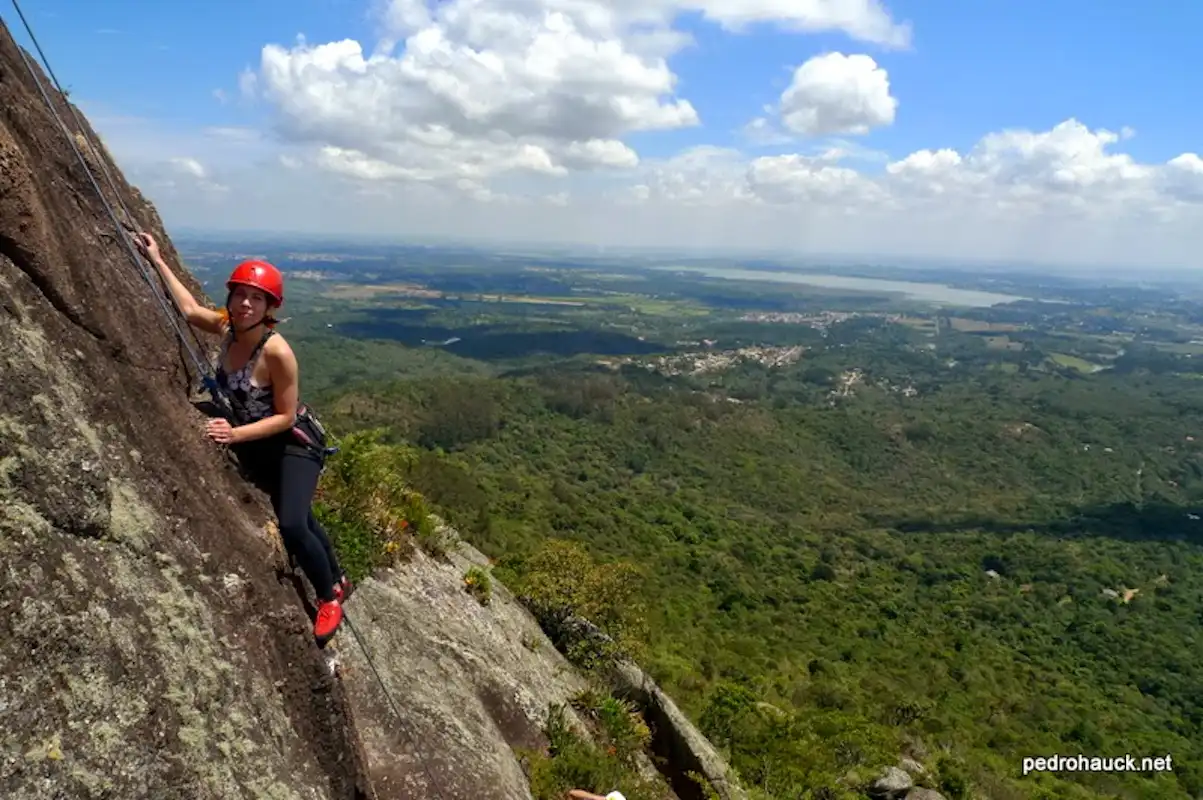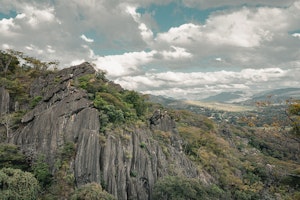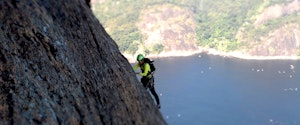The entire landscape of Brazil is an evocative whirlwind of one stunning feature after the next. As the fifth largest country in the world by both land mass and population, there is quite a lot to love about this Portuguese-speaking country in South America. Its incredible geography and geology has developed into one of the most unique territories on Earth. Beckoning to travelers and adventurers alike for centuries, the country as a whole is a veritable rock climber’s dream.
The continent has a high number of compelling climbs, but nothing can compete with the relentless beauty of Brazil’s landscape. What it lacks in overall height (compared to the Andes) it makes up for in unusual geology. Its geography is defined by rain forests and dunes to tablelands and monoliths. Each climbing location offers a special view into a unique Brazilian land form.
The tropical climate that symbolizes the country leaves a lasting mark on the terrain, making rock climbing a year-round sport. Climbing gyms are common in Rio de Janeiro and Sao Paolo, but they simply can’t compare to the real thing.

Rock climbing is quickly developing as one of the most exciting sports in Brazil, and with good reason.
Check out some of the amazing programs offered by our certified guides in Brazil!
3 Reasons to Go Rock Climbing in Brazil
Access Meets Nature
Within a few minutes from the bustling city, travelers are swept into the magic of Brazilian nature.
Believe it or not, you can enjoy a fulfilling rock climbing trip without leaving Rio de Janeiro – the city or the state. The natural beauty of the wilderness is highly valued at close range, and a city like Rio has a ton of great spots. You can enjoy simple routes (like Pao de Açucar, or “Sugarloaf”) at the heart of the city, or make your way to more dedicated ascents but a car ride away.
The other states have a similar access from city to wilderness. Curitiba, southwest of Sao Paolo, boasts views of the lush countryside from the top of its rocks. Just a forty kilometer drive from the city and you will be overlooking endless greenery and enchanting Brazilian terrain.
The nature you see is absolutely breathtaking, given that Brazil is the most biologically diverse country in the world. Climbers can scale monoliths and rock slabs with uncompromising views of green into the horizon, meandering rivers in undisturbed wilderness, and an all-around peaceful outdoor experience.
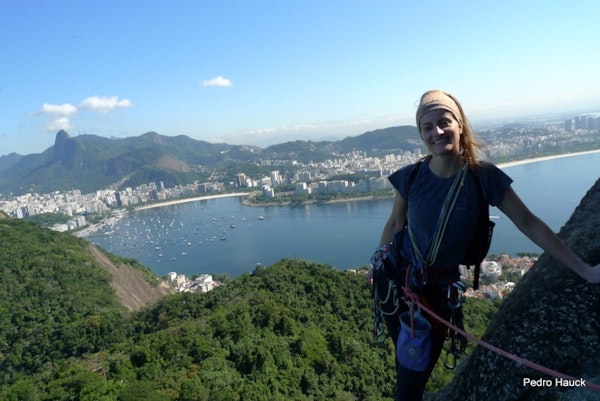
Open to Everyone
A little bit of climbing experience may be necessary for some of the most complex networks of ascents, but even beginners can find what they are looking for in Brazil. Trad and sport climbers are most satisfied with the options, but courses for greenhorns are designed to give the inexperienced a chance to feel the power of Brazilian rock and see what incredible world from the top of its climbs.
Many basic level programs will spend multiple days on various routes so climbers can actually see the difference between pitches. This is a great way to improve rapidly and expand on a foundation of skills, but also to pick up different perspectives at a location. A four day rock climbing course in Curitiba might spend a couple days building a functional knowledge of the sport before applying in practical instruction on local rocks.
There aren’t many places around the world where you can spend a week climbing in nature, but Brazil’s raw beauty makes it almost mandatory for all levels. When visiting Rio, Itatiaia, or Curitiba, your program will match your skill level with epic views, making the experience as unforgettable to the rookies as it would be for the seasoned vets.
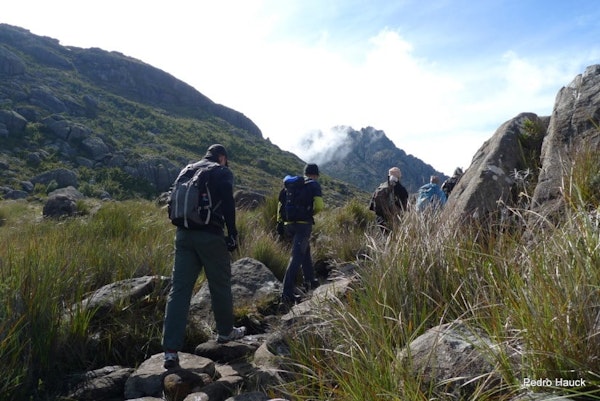
Incomparable Culture
When the climb ends, it doesn’t have to be time to leave. Maybe if you are climbing in a less exciting location, or a more remote location, but not in Brazil. Rio is notorious for its vibrant nightlife and immaculate beaches (think Copacabana and Ipanema). Build in a few days of your trip to safely enjoy the culture of this South American gem.
Most of the great climbing areas are in the south, but the north has a wealth of natural beauty as well. Double down on your adventure and spend a day or two kitesurfing in Fortaleza and its hearty local seafood. Admire the waterfalls on your way to the top of Mount Roraima for an extended vacation in the rural communities near the Venezuela and Guyana borders. Why not grab a guide and head out on a hiking trip anywhere across the Brazilian expanse to give yourself a fresh look at another regional marvel?
The options are endless and rewarding on every level. If you come in late summer, Carnaval might whisk you away in a midnight Samba. The cultural identity of each corner is extremely rich – rock climbing is a great way to dig into the culture and make the most of an activity-filled vacation.
Where To Go
1| Pao de Açucar
There are a surprising number of wonderful places to climb in Rio de Janeiro, from near the city center and into wilderness encircling it, and Pao de Açucar is the best place to begin.

Pao de Açucar, or Sugarloaf, is located in the heart of the city and has a vast network of routes. The location is perfect – right at the head of Guanabara Bay – as are the vistas from almost every angle. A bit of climbing experience is necessary, but you certainly don’t have to be a pro to enjoy it. This UNESCO World Heritage Site rises 396 meters high, and even has a cable car that takes you to and from the top.
Climbs run anywhere form 5.6 Grade to 5.11 Grade, so it serves as a great place to unwrap trad and sport climbing as well as improve on intermediate skills. Consider Chamine Stop (5.6) for a lighter multi-pitch load, or take on Via dos Italianos (5.10) for a true test of sport climbing skill.
In Brief
Discipline: Trad and sport climbing
Difficulty: All levels
Fly Into: Rio de Janeiro – located at the head of the bay, you can’t miss it
Duration: 1+ days
Check out this great 1+ day program climbing at Pao de Açucar with certified guide Alex!
2| Salinas (Tres Picos)
If you have time to kill, this could be your spot. Salinas is an iconic long-ascent destination for trad climbers, so you can plan on at least a full day rising on the rock. Located in Tres Picos State Park – the largest in the state of Rio, the “three peaks” in question are the Pico Major, Pico Medio, and Pico Menor, with the additional Capacete (helmet) as the cherry on top.

Pico Major and Capacete have unbelievable climbs, including a 10-hour classic ascent to the summit on Via Leste (5.9). There are over 100 routes here and lines of up to 19 pitches, so mixed climbers will have a field day – or seven – scouring the rock for big wall success. Approaches can take up to an hour in some places, so this is a location for the dedicated climbers to get lost on an ascent.
The routes in Salinas are notably high, which translates into jaw-dropping views of Brazil’s countryside. This makes a long, multi-day climb more than worth it when you look out at the immense beauty of the country.
In Brief
Discipline: Trad climbing
Difficulty: Intermediate
Fly Into: Rio de Janeiro, then drive about 150 kilometers to the northeast to reach Tres Picos (3 hour drive)
Duration: 2+ days
Book this great two-day rock climbing trip in Salinas NOW!
3| Anhangava (Curitiba)
Not to be outdone by its famous neighbor in the north, Curitiba and Anhangava is a sport climber’s dream. With tons of routes ranging from 5.7 to 5.12, this granite slab-work has chimneys and cracks for intermediate to advanced rock climbers.
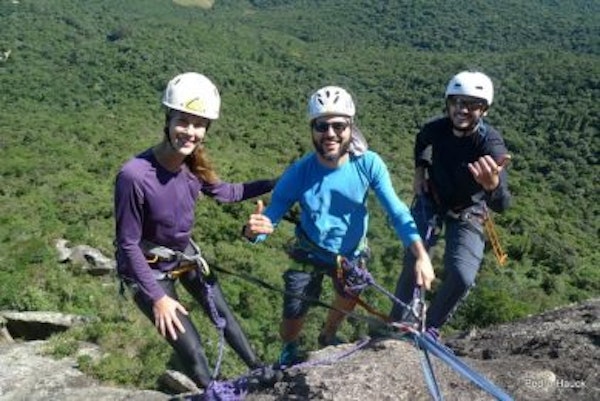
Located in the city of Quatro Barras in the state of Parana, beginners are also welcome here to hone their skills and prepare for the longer ascents. A bit of experience is always considered an asset, and those who come equipped with the skills can take on the most daunting of the roughly 200 routes.
The climbing area has a nice hike for the approach, and is nestled in a lush forest setting. Looking out at the wilderness of Curitiba and Parana is more than just beautiful; these climbs will stay with you long after you leave Anhangava.
In Brief
Discipline: Sport climbing
Difficulty: All levels
Fly Into: Rio de Janeiro and then transfer to the Afonso Pena International Airport (CWB)
Duration: 1+ days
Enjoy a four-day rock climbing course in Curitiba and climb Anhangava with certified guide Pedro!
4| Itatiaia
Between Rio de Janeiro and Sao Paolo is Itatiaia National Park and the climbs of Itatiaia. These climbs are tall, reaching about 1,800 meters. Course granite makes the climbs particularly satisfying, as does Agulhas Negras (2,787m), Brazil’s eighth highest peak. Sport climbing is most popular here, but some trad climbs are also available. Routes are still being developed, and the park is large enough, both in the higher and lower areas.

Its location makes it easily accessible, and the terrain is a great way to combine hiking and mountaineering with your climbing program. Climbs are varied, with some scrambling up the summits and 5.11 and higher graded pitches. Multiple days are recommended to find the best climbs in the park for your specific skills and needs.
Itatiaia was the first national park in Brazil, so if you are taking on its gorgeous summits or just heading up a slab, you will appreciate the rugged beauty both of the surrounding park and of the climb itself.
In Brief
Discipline: Trad and sport climbing
Difficulty: Intermediate
Fly Into: Rio de Janeiro or Sao Paolo, and then drive towards the park (there are two entrances)
Duration: 4 days to 1 week
When Is the Best Time To Go Rock Climbing in Brazil?
Brazil has the fortunate climate and geography to benefit from great weather, so rock climbing can be done all year round. Dry season occurs from late May through October, Brazil’s winter, though it doesn’t get as cold in climbing destinations. The months from June through September can actually offer some of the best climbing conditions in the country. Temperatures are considered ideal for physical activity.
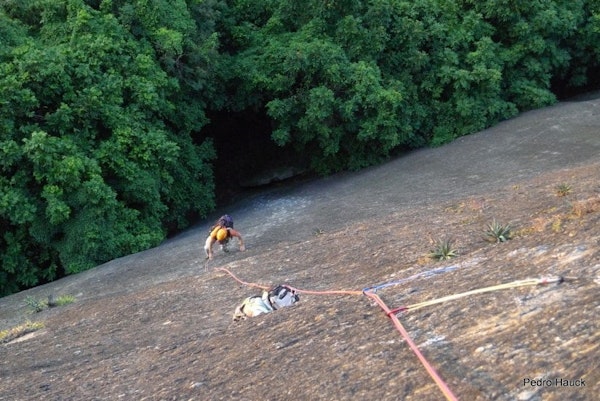
Most of the best rock climbing areas in the southern parts of the country are warm and sunny through all of the seasons. The rainy season falls from about November to April, with most precipitation during the height of summer (January and February). The climate, for the most part, is comfortable and pleasant.
How Much Does It Cost?
Fortunately, Brazil offers affordable programs in incredibly beautiful places. As always, the price of a program depends on the number of participants, days, inclusions, etc. Many trips will have group climbing equipment included, but some will only include the guiding fee. It is important to speak with a guide and make sure you are getting the most from your trip.
For a one-day climbing trip in Brazil, prices generally start at $46 USD per person for a group of four people. A private climbing trip for just you and the guide begins around $90 USD. For those who are looking for a more substantial program, a seven day program for two people starts at $400 USD per person.

For longer trips, camping equipment or lodging, food, and other amenities may or may not be included to influence the price. Make sure you outline what you are looking for with a guide before you book so you know that you are receiving everything you need regarding logistics and accommodations.
Don’t let the dream of a lifetime slip away! Book your trip to Brazil NOW and climb some of the most beautiful and intriguing rocks on Earth in a paradise south of the equator!
